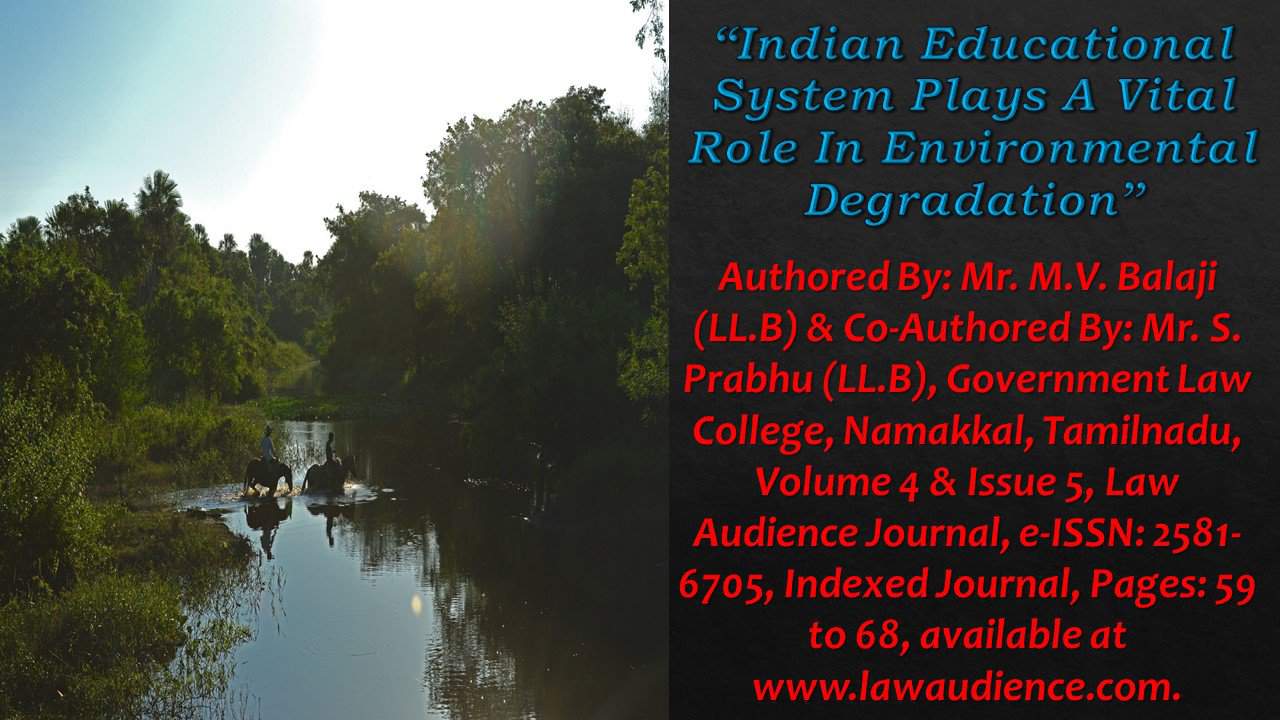Click here to download the full paper (PDF)
Authored By: Mr. M.V. Balaji (LL.B) & Co-Authored By: Mr. S. Prabhu (LL.B), Government Law College, Namakkal, Tamilnadu,
Click here for Copyright Policy.
I. INTRODUCTION:
Indian Educational System plays a vital role in Environmental Degradation by exploiting various Natural Resources of our Nation. Here, in this Article we are focusing especially on how our Educational System leads to the root cause for Deforestation. The usage of papers by the Educational Institutions and Educational Sectors of our Nation are increasing more and more on daily & day to day activities. The other Institutions also using and wasting papers, but Education Industry stands number one in paper usages and wastages. So, here, we are in focus on Deforestation due to Papers and its usages, and Educational Methodologies of our nation. Also, we analysed, the present Educational System’s Teaching, Learning and Examination patterns here. At the end we made suggestions to implement the Digital and Technological method of Educational Systems i.e., e-reading, e-learning, and so on, rather than the traditional Educational Methodologies, for reducing the paper consumption and other bye products made from trees and wood. The role of Environmental Law and its related Constitutional Law should act the major play here for new enactments of law or ideologies by law makers on prevention of natural resources and also for the protection of trees and forests. ‘Save Papers – Save Trees – Save Forests – Save Environment’, this will be our motto, which is to be considered through this Article.
II. CRITICAL ANALYSIS:
Environment & Causes for Degradation: Environment is living and non-living things which surround us that consists of plants & animals, and objects like water, air, light, soil, temperature, etc. The major causes for Environmental Degradation are Increase in Population Rates, Industrial Developments, Deforestation, Urbanization, Science and Technology, Social and Economical Dimensions, Natural causes etc.
From the above mentioned causes of Environmental Degradation, here, we discuss on Deforestation and how it affects the environment by its various nature.
Deforestation: Deforestation means removal of large number of trees from forests or other lands for the Human Activities Facilitation. The loss of trees can cause Environmental Deterioration like Climate change, Desertification, Ecological Imbalances, Soil Erosion, Flooding, Green House Effects, and Global Warming etc. Hence, to save trees, avoid using products made from trees, like oil, pulp, papers, gum, woods, etc.
Causes and Effects of Paper on Deforestation: In most of the world’s important places, the unsustainable production of papers and its consumption contributes to Degradation and Deforestation. Irresponsible harvesting and establishment of pulp plantations on natural forests can threaten fragile ecological systems and leads to pollution. Paper production requires a lot of trees and contributes to air pollution and water pollution, also it uses lot of energy resources and that may produce solid wastes and greenhouse gases. A very important factor to be noted out that the production of papers requires the removal of trees from forests and this create negative impacts on absorption of carbon dioxide by trees from the environment space which leads to the production of large amount of pollutant gases. The paper production contributes to 80 % more greenhouse gases and 50 times more water pollutants than plastic. This clearly indicates that the pollutants created by paper manufacturing process are more dangerous than plastic pollutants.
Calculation on Number of Papers Equals a Tree, based on analyzing & the existing reports: The various existed researches have indicated the number of papers we obtained from a tree / trees. The calculations analysed by the Environmental Analysts are shown below:
- To make about 1000 kg / 1 ton of paper, it takes about 17 trees (11 metres tall).
- To make 1 ton of uncoated virgin (non-recycled) office paper, it takes 24 trees.
- We can get around 8000 to 9000 A4 sheets of paper from a standard pine tree which has 45 ft of the usable trunk with eight inches of its diameter.
Internationally, ISO defines a standard ream as 500 sheets of paper that are of the same size and quality. To determine the ream weight of any given size sheet, multiply the square inches in the given size by the given basis weight; divide the result by the square inch area of the basic size.
In simple words, 1 tree makes 17 reams of paper, or 1 ream = 6 % of one tree.
Hence from the above details, we conclude that, from 1 tree we can get around 8500 A4 sheets.
Education Industry in India: Indian Education Industry consist different sectors includes Technical and Non-Technical Educations. Also subcategorized as Higher Education and School level Education. The School Education Industry divided into Nursery, Primary, Elementary, Secondary and Higher Secondary Levels. School Education Segment covers Central Board and State Board affiliated Private Schools, Government Schools. Higher Education Industry can be divided into two segments as Regulated (Professional, Non-Professional, Technical, Non-Technical Degree courses) and Unregulated (Few Degree courses in Distance Mode and Non-Regular). Higher Education Segment covers Central, State, Private Universities, Private Colleges and Technical & Research Institutions.
System of Education in India: In India, the Educational methodology followed by the Institutions is still traditional i.e., Reading the Text Books, Writing in Board, Teaching orally, Lot of Writings on Papers, Descriptive Exam Patterns and so on. This method of Educational System is still followed by 99% of the Indian Education Industry. There are many drawbacks in this system of education. The Paper usages and wastages are also lot and leads to non-development of the country.
Problems in Indian System of Education: The best system of education is known for its practical learning but in India still followed the theoretical and descriptive procedures through paper based and text book based studies. According to UNESCO’S education report for India 2021, there were vacant of 11.16 lakh teaching positions in schools. This clearly indicates the shortage of Teacher-Student Ratio. Education system should focus on socio-economic factors but Indian system of Education is still business point of view only, not developed much. According to a survey report in 2020, India stands 33rd rank in the top ranked World Universities list. The Countries like USA, UK, Australia, Sweden, Netherlands, France, Denmark and Canada are at top, because all these countries followed the practical exposure to learning a lot, rather than theoretical procedure. We can say that wherever the practical exposure is in high level, the critical thinking and the logical reasoning will be well amongst the learners and also the paper consumption will be reduced because of non-descriptive answers and procedures.
Calculation on Number of Papers Used and Number of Trees Destroyed by a Graduate in India, based on analyzing & the existing reports: The Calculation on Number of Papers used and Number of Trees destroyed by an Indian Citizen is not at all an easy task. The Calculation is done here approximately by following various assumptions and various survey reports. The aim of calculating the paper usages by a graduate in India is to provide awareness among the Indian citizens, Educational Industries, Law Makers and all persons related to Environmental protection, that, how many millions of trees we lost because of non-improved and business minded Education system of Indian Nation. Because of lot of Paper consumption by the education industry in the past and in the present, we lost millions of trees so far and we suffered a lot because of changes in environmental nature. The aim of this Article is to change the future by changing the Education methodology in India. Let us see the survey reports and calculations below for reference.
An USA survey reported that, ‘A typical school uses an average of 2000 sheets per day. In 160 working days of a year, a school will chew through over 320000 sheets of paper per year’. This survey is complicated to Calculate in INDIA because of lakhs of schools and many thousands of colleges. So, we analysed and calculated the loss of trees through the usage of papers by a person since from his/her schooldays to obtain a graduate degree i.e., 17+ years of Education.
| Nature of study | Number of Papers used for Text Books (in approximate) |
Number of Papers used for Writing Works
(in approximate) |
Number of Papers used for Descriptive Exams (in approximate) |
Total Papers Used |
| Primary
(Age: 5 to 11) |
For 35 Books, 80 Papers / Book is 2800 | 3500 | For 35 Subjects, 24 Papers / Subject is 840 | 7140 |
| Post Primary (Age: 11 to 14) |
For 15 Books, 100 Papers / Book is 1500 | 2000 | For 15 Subjects, 30 Papers / Subject is 450 | 3950 |
| Secondary
(Age: 14 to 16) |
For 10 Books, 150 Papers / Book is 1500 | 2500 | For 10 Subjects, 60 Papers / Subject is 600 | 4600 |
| Higher Secondary (Age: 16 to 18) | For 10 Books, 250 Papers / Book is 2500 | 3000 | For 10 Subjects, 60 Papers / Subject is 600 | 6100 |
| Graduate (Professional/ Non-professional ) | For 40 Books, 200 Papers / Book is 8000 | 4000 | For 40 Subjects, 40 Papers / Subject is 1600 | 13600 |
Grand Total: 35390
All the values above mentioned are based on our personal experience and survey conducted orally with few Educational Industry regarding the minimal usage of papers in Tamilnadu state. Here we pointed that the average usage of papers by a graduate person till from his / her Primary level of Education to obtain a Graduate Degree as 35000+ papers. If the person is a dual degree or triple degree or multiple degree holders, the paper consumption rate by that person is more compare to this basic value of 35000+ and can reach up to 40000+ papers.
From the earlier analysed Calculation on Number of Papers Equals a Tree, we know that 1 tree gives around 8500 A4 sheets. Here in this Calculation on Number of Papers used by a Graduate, we obtain that as around 35000 to 40000+ Papers.
To obtain a professional or non-professional degree in his / her life, those persons used around minimum of 40000+ papers including printed books, reference books and other materials, non-printed papers, recycled papers, virgin papers and other bye products of trees which is used for making students stationary items. So, from this analysis, we conclude that, A person who is an Indian Citizen, to became a graduate, he / she destroyed the life of at least 5 trees. The destruction of fully grown 5 trees is the very minimal count, but in the actual it may be twice of this count. This count is only by the educational sector usage of a person, if we look on the total usages and wastages of trees by a person in his / her lifetime, it is very difficult to calculate.
In India, at present there are around 1000+ Universities and multiple number of Deemed Universities and Thousands of Private Colleges and Hundreds of Government Colleges which are running under the Universities control and UGC. As per government reports (National Employability Report & All India Survey on Higher Education – AISHE) around 30-35 lakhs students graduated every year in India. Also, as per the 2011 Census, about 8.15% (9.9 crore) of Indian Population are graduates, so if we consider at present, around 13.5 crore graduates are there in India with single degree alone. So, when we look at this report, we ourselves think of the loss of trees. In the developing rate of educating people’s ratio year on year, the degradation and destruction rate of natural resources also rapidly increasing year by year.
So, from the above reports and the calculation of losses of trees, and also unhealthy environment and natural resources availability, the Environment Analyst and the Law Makers have to focus on this and make the right decision to provide the safety and healthy environment to the future generation citizens of the nation. We furthermore mentioned below about our ideologies for less consumption of paper, the Provisions of Indian Laws discussed on Environmental Protection, also suggesting E-learning methods to overcome this problem, and so on.
III. SUGGESTIONS AND IDEOLOGIES:
Reasons to Use less Amount of Papers: The following are the valid reasons to use a smaller number of papers by an individual or a group of persons of Indian nationals to protect our environment from natural destruction. The reasons are as follows:
- 1 tree can able to produce only 17 reams of paper on average, thus paper production requires lot of fully grown trees, and that also takes about 100 years to grow, it contributes to Deforestation.
- Each and every ton of paper produced generates 1.5 tons of carbon dioxide equivalents and thus for producing 17 reams of paper from 1 tree, 110 pounds of carbon dioxide released into the atmosphere which leads to Air pollution.
- The Fossil fuels are used for Ink Production and the inks that are used in printing purpose contain chemicals, oils and other substances that cause damage to the environment.
- Depending on the mill which produces the pulp and papers, the water footprint of printing and writing paper is estimated to be between 2 to 13 litres for an A4 sheet (300 and 2600 m3/ton), contributes to Water wastages.
Provisions of Law: The Provisions of Environmental Law and the Constitution of India has discussed a lot on Environmental and its natural resources protection with the Indian Citizen’s Roles, Rights and Duties. Some of the Provisions of these two laws that discussed about the Environment are mentioned below. According to the Constitution of India, the following are the Articles of Fundamental Rights related to Environmental Protection and Development. They are Article 21 (Life and Personal Liberty), Article 19(1)(a) (Freedom of Speech and Expression), Article 19(1)(g) (Right of Citizens to practice any profession, to carryon any occupation, trade or business), Article 14 (Equality before law), Article 32 (Writ Jurisdiction of Supreme Court), Article 26 (Writ Jurisdiction of High Court). The Fundamental Duties of the state and the citizens of India are: Article 48-A, says, “The State shall endeavour to protect and improve the environment and to safeguard the forests and wildlife of the country”. Article 51-A(g), “It shall be the duty of every citizen of India to protect and improve the natural environment including forests, lakes, rivers and wildlife and to have compassion for living creatures”. Article 51-A(j), “It shall be the duty of every citizen of India to strive towards excellent in all spheres of individual and collective activity, that the nation constantly rises to higher levels endeavour and achievements”. There are many enactments related to Environmental Protection under the Environmental Law. Some of the important Acts regarding Environmental Protection are, The Environment (Protection) Act 1986, The Water (Prevention and Control of Pollution) Act 1974, Air (Prevention and Control of Pollution) Act 1981, Indian Forest Act 1927 and The Forest (Conservation) Act 1980, Wildlife Protection Act 1972, The Biological Diversity Act 2002 and so on. All the above mentioned Environmental Acts are focused on the Protection of natural resources and also discussed on the importance of trees for controlling pollution and other natural disasters. The Trees are the major source for Environmental Protection, which is mainly discussed under Environment (Protection) Act 1986 and the deforestation is discussed under the Forest (Conservation) Act 1980. Many Forest Conservation Rules are amended for the Protection of Forests and the Trees present in it.
Changes to be made in the Education System: As far the discussions made above, there should be changes and updating to be made in the Indian Education System and its methodologies. The major changes needed in the Education system is that, the existing traditional method of paper usage system of education should be updated to fully digitalized version or at least the changes to be made in step by step procedure, by reducing the paper usages. Also, the examination system of descriptive type pattern should be changed or banned and the objective type of exam system should be implemented. This objective type of examination system has many advantages over descriptive type of examination system. The critical thinking and the logical reasoning ability of the learners are in better exposure when they work out on objective type of examination system and also the paper consumptions will be less in this type of examination system.
Advantages of Digital or E-system of Education over Printed Papers Education: The E-system can hold thousands of E-Books in a small storage limit, but bulky printed and paper materials hold lot of space. The cost of E-Books is less compared to printed books because there are no expenses of paper printing, fancy covers, packing and shipping costs and so on. E-Books are easily portable than physical books. There are lot of advantages on E-system of Education rather than old and traditional paper based Education Method. At the end, it all comes to our knowledge that E-system of Education like E-learning, E-writing, E-Journals, E-Reading, E-Books, E-Publishers etc and all related to E-Systems will save the papers and its wastages. So, the implementation of E-system on Education Industry brings major changes and revolutionary in the natural resources and environmental protection. This revolutionary will save trees, save forests, save environment. Also, the deforestation ratio will come down in slower manner. We consider this revolutionary as a start-up of Environmental Protection by stop deforestation and save the natural resources from other destructions. As we said earlier that Indian Educational System plays a vital role in Environmental Degradation, if there will be an implementation of digital education methodologies then we could say Indian Educational System plays an important role in Environmental Protection. This action or wordings are depending upon the Enactment of Laws by the Government and followings of the Education Industry.
‘Save Papers – Save Trees – Save Forests – Save Environment’: The Scientific studies of environmental analysis have proven that 1000 kgs of paper equals seventeen fully grown trees. So, if we recycle 1000 kgs of used or unwanted papers, we can save the life of seventeen trees, 1440 litres of oil, 2.3 cubic meters of landfill space and 26500 litres of water. Also recycling of papers saves 4000 kilowatts of energy and reduces pollution. For the Production of one ton of papers, it requires two to three times its weight in trees. So, making paper from recycled content produces less air pollution (74% less) and less water pollution (35% less) than that of Virgin paper fibres. i.e., To produce 1000 kgs of Virgin paper, it requires 24000 gallons of water and for 1000 kgs of Recycled paper, it requires 12000 gallons of water. These statements are based on paper usages only. If we consume a smaller number of papers, the greater number of trees can be saved. Also, to save trees, the government and the education industry should make revolutionary changes in the education systems; then the larger number of trees can be saved. If larger numbers of trees are saved, certain number of forests can be saved and the whole natural environment can be saved.
IV. CONCLUSION:
Thus, from the critical analysis and the calculations regarding paper production from trees, paper usage by an individual of the nation, paper production leads to environmental defects, and also the role of educational industry in the environmental degradation, we conclude here with lot of answers on how to save trees and forests. In this Article, we focused especially on Paper consumption, usages and wastages of papers by the education industry. If the education industry made changes on its traditional method to fully digital method, then the environment will be protected and safe, because education industry is the number one in paper usages. If there is no chance to completely change to fully digital, at least reduce paper consumptions by eliminating descriptive type of education pattern and including objective type of education pattern.
Paper is just a physical medium that we can use to convey ideas and also, we can use it to create various learning materials from simple worksheets to elaborate textbooks. Even though on researches said paper method working for students, we the present generation should aware of natural resources to be protected for future generation. With the increasing population range, the destroying of natural resources will cause many losses for human beings and also other living things. Already the world is in destroying stage because of environmental pollutions. If the education system changes to digitalize and the paper usage by the education sector diminished, then the environment could be started protecting. Then only the upcoming and future employers and employees use the digitalized technology in the entire industrial sector, which can lead to conserve the forests and many living organisms. If the education industry fails to make change in their methodology, the enforcement of law should be made against the education industry by the Law Makers.
‘Last But Not the Least’, we should encourage the persons or entity, who are already involved in the digitalized educational sector. The digitalized education includes E-Readers, E-Books, E-Learners, E-Publishers, E-Journals and so on. The Persons already involved in digital methodology of education obeys the fundamental duties which are mentioned in the Constitution of India Article 48-A and Article 51-A(g). The fundamental duty of each and every citizen of India and also the state is that to protect the forests, their natural resources and the natural environment from degradation. So as per our Article data, the fundamental duty of every citizen of the nation is ‘Save Papers – Save Trees – Save Forests – Save Environment’.
Cite this article as:
Mr. M.V. Balaji & Mr. S. Prabhu, “Indian Educational System Plays A Vital Role In Environmental Degradation”, Vol.4 & Issue 5, Law Audience Journal (e-ISSN: 2581-6705), Pages 59 to 68 (10th January 2023), available at https://www.lawaudience.com/indian-educational-system-plays-a-vital-role-in-environmental-degradation/.




